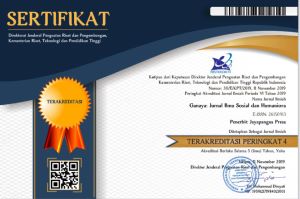Veronica's Artificial Intelligence (AI) Business Communication Strategy Analysis as My Telkomsel Customer Service Case Study of Telkomsel Customers in Bengkulu
DOI:
https://doi.org/10.37329/ganaya.v8i2.3998Keywords:
Communication, Artificial Intelligence (AI), TechnologyAbstract
Communication evolves alongside technological advancements, shaping how individuals and businesses interact. One of the most widely adopted innovations in recent years is Artificial Intelligence (AI), which has transformed various sectors, including customer service. This study examines the implementation of Veronika, an AI-powered virtual assistant in the MyTelkomsel application, as part of Telkomsel’s business communication strategy. The findings indicate that Veronika has significantly improved customer service efficiency, increasing response speed by up to 40% and reducing operational burdens on call centers. By integrating AI into digital platforms such as WhatsApp and MyTelkomsel, Telkomsel has enhanced accessibility and service flexibility for its customers. Additionally, Veronika’s adaptation of global AI technology to the local Indonesian context has created a more relevant and user-friendly experience, supporting changes in customer behavior as explained by Technological Determinism Theory. However, despite these advantages, challenges remain, particularly in service personalization and AI’s ability to understand complex queries, which affect user satisfaction. These limitations highlight the need for continuous technological improvements, particularly in Natural Language Processing (NLP) and customer interaction models. This research contributes to the ongoing discussion on AI-driven customer service, offering insights into its strategic benefits and limitations. By addressing existing challenges, companies can further refine AI applications to enhance digital engagement and customer loyalty. Future studies should focus on optimizing AI-human interaction to ensure a seamless, personalized customer service experience.
References
Arly, A., Dwi, N., & Andini, R. (2023). Implementation Of The Use Of Artificial Intelligence In The Learning Process Of Communication Science Students In Class A. Proceedings of the National Seminar, 2.
Akmalia, A. N. (2020). Analysis of the Adoption Level of Digital Banking Services Using the Diffusion of Innovation Theory (Object of Study: Jenius by Bank BTPN in Bandung and Jakarta). E-Proceeding Telkom University Open Library.
Anggraini, R., & Zinaida, L. (2022). The Role Of Social Media Instagram In Improving Customer Communication Through Interactive Features. Journal of Digital Marketing, 10(2), 45-60.
Ardiansyah, D., Satria, F., & Nugroho, A. (2021). Ai Design In Business Process Management: A Technical Perspective. Journal of Artificial Intelligence and Business Strategy, 8(1), 12-25.
Duha, H. A., Putri, S., & Wijaya, B. (2022). Consumer Behavior Trends In Ai-Driven Digital Platforms: A Case Study Analysis. Journal of Consumer Behavior and Digital Transformation, 14(3), 102-118.
Fidiyanti, F., Subagja, A. R., Wachyu, R. P., & Madiistriyatno, H. (2023). Analysis Strategy Development Business Using Artificial Intelligence Technology. Journal of Comprehensive Science (JCS), 2(7), 1994-2001.
Hidayat, Z. (2016). The Impact of Digital Technology on Changes in Public Media Consumption. Komunikologi: Jurnal Ilmiah Ilmu Komunikasi, 13(2).
Kasmir. (2014). Customer Service Management: Theory And Practice. Jakarta: PT Raja Grafindo Persada.
Lee, K., & Shin, H. (2023). AI-Powered Chatbots In Telecommunications: Enhancing User Experience And Reducing Operational Costs. Journal of Artificial Intelligence and Business Communication, 18(4), 56-72.
Mukarom, Z. (2021). Context Based Communication Theories. Bandung: PT. Remaja Rosdakarya.
Mulyadi, R., Setiawan, H., & Lestari, D. (2023). The Evolution Of Communication Technology And Its Impact On Digital Business Adaptation. International Journal of Communication and Business, 12(4), 78-95.
Main, D. P. (2010). Teenagers' Satisfaction With The News Of The Skh Kompas Jogja Youth General Rubric Descriptive Study of the Satisfaction of Madrasah Aliyah Ali Maksum Yogyakarta Students as Teenagers with the SKH Kompas Jogja Youth Youth Rubric News. EProceeding UAJY.
Rachmawati, R. (2011). Role Mix Marketing (Marketing Mix) Against Increase Sales (a A study of Restaurant Business). Journal of Engineering Competency, 2(2).
Ririh, D., Permana, A., & Susanto, H. (2020). AI Implementation Across Sectors In Indonesia: Challenges And Opportunities. Indonesian Journal of Technology and Society, 7(3), 55-72.
Ritonga, E. Y. (2018). Agenda Setting Theory in Communication Science. Jurnal Simbolika Research and Learning In Communication Study, 4(1), 32-41.
Saidah, L. (2021). Business Models In The Ai Era: A Framework For Digital Transformation. Journal of Business and Innovation, 6(2), 34-50.
Smith, J., Brown, L., & Taylor, M. (2022). AI-Driven Customer Service: Enhancing Response Times And Personalization In Telecommunications. Journal of Business and Technology, 15(2), 87-104.
Tysara, L. (2022). 11 Definitions of Collaboration According to Experts, Check Out the Types from https://www.liputan6.com/hot/read/4852462/11 pengertiankolaborasi-menurut-para-ahli-simak-jenis-jenisnya
Verasius, D. A. Several Definitions Of Data, Information And Information Systems According To Several Experts From https://binus.ac.id/malang/2020/12/beberapadefinisi-tentang-data-informasi-dan-sistem-informasi-menurut-beberapaahli/
Downloads
Published
How to Cite
Issue
Section
License
Copyright (c) 2025 Farhan Fajri, Desy Misnawati (Author)

This work is licensed under a Creative Commons Attribution-ShareAlike 4.0 International License.
An author who publishes in the Ganaya : Jurnal Ilmu Sosial dan Humaniora agrees to the following terms:
- Author retains the copyright and grants the journal the right of first publication of the work simultaneously licensed under the Creative Commons Attribution-ShareAlike 4.0 License that allows others to share the work with an acknowledgement of the work's authorship and initial publication in this journal
- Author is able to enter into separate, additional contractual arrangements for the non-exclusive distribution of the journal's published version of the work (e.g., post it to an institutional repository or publish it in a book) with the acknowledgement of its initial publication in this journal.
- Author is permitted and encouraged to post his/her work online (e.g., in institutional repositories or on their website) prior to and during the submission process, as it can lead to productive exchanges, as well as earlier and greater citation of the published work (See The Effect of Open Access).
Read more about the Creative Commons Attribution-ShareAlike 4.0 Licence here: https://creativecommons.org/licenses/by-sa/4.0/.








